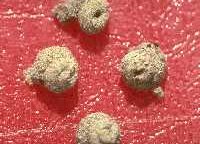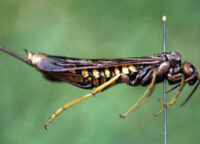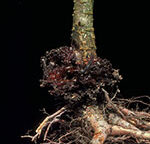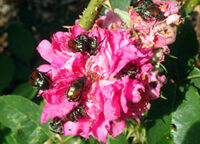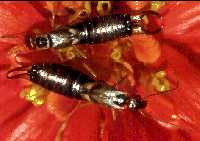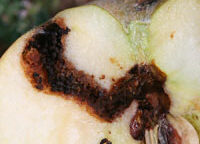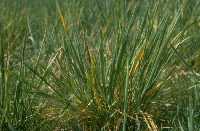- 07, 29, 2015
- No Comments.
- By
Snailcase Bagworm – 5.580
Print this fact sheet by W.S. Cranshaw* (7/14) Quick Facts… The snailcase bagworm is an unusual insect that lives within a small, coiled case of soil and silk. Although snailcase bagworms feed on various plants, the primary concern occurs when full-grown caterpillars migrate and attach themselves to the sides of buildings, fencing, mailboxes and similar […]
Take a Tour- 07, 29, 2015
- No Comments.
- By
Pigeon Tremex Horntail and the Giant Ichneumon Wasp – 5.604
Print this fact sheet by W. Cranshaw* (7/13) Quick Facts… The pigeon tremex is a type of non-stinging wasp, known as a horntail. The giant ichneumon wasp is the most common natural enemy of the pigeon tremex. Pigeon tremex are not considered serious pests since attacks are limited to trees and limbs that are in […]
Take a Tour- 07, 28, 2015
- No Comments.
- By admin
Peachtree Borer – 5.566
Print this fact sheet by W.S. Cranshaw* (1/18) Quick Facts… The peachtree borer is the most destructive insect pest of peach, cherry, plum, and other stone fruits in Colorado. Damage is done by the immature larvae, which chew beneath the bark of the lower trunk and larger roots. Insecticide sprays applied to the lower trunk […]
Take a Tour- 07, 27, 2015
- No Comments.
- By
Lady Beetles – 5.594
Print this fact sheet by W.S. Cranshaw * (7/14) Quick Facts… About 80 different species of lady beetles (a.k.a., “ladybugs” and “ladybirds”) are present in Colorado. Adults and larvae feed on a variety of pest insects and mites, notably aphids and scales. Lady beetles can be invited into a garden by providing plants that adults […]
Take a Tour- 07, 27, 2015
- No Comments.
- By admin
Japanese Beetle – 5.601
Print this fact sheet by W. Cranshaw* (3/18) Quick Facts… Japanese beetle adults chew flower blossoms and leaves of many commonly grown plants. Japanese beetle larvae are a type of white grub that feeds on the roots of grasses. Adults are best controlled by handpicking or by use of certain insecticide sprays. Japanese beetle traps […]
Take a Tour- 07, 27, 2015
- No Comments.
- By
Grasshopper Control in Gardens and Small Acreages – 5.536
Print this fact sheet by W.S. Cranshaw and R. Hammon* (1/13) Quick Facts… Grasshoppers are the most difficult insect to control because they are highly mobile. All grasshoppers lay their eggs in soil. There are over 100 species of grasshoppers in Colorado. During periods when local outbreaks are developing, control usually involves using sprays or […]
Take a Tour- 07, 22, 2015
- No Comments.
- By
European Earwigs – 5.533
Print this fact sheet by W.S. Cranshaw* (7/14) Quick Facts… The common earwigs found in Colorado are an introduced insect that arrived in the state during the 1950s. Occasionally, earwigs damage soft parts of plants. However, the main food of earwigs is insects, including plant pests such as aphids. Earwigs like to hide in dark, […]
Take a Tour- 07, 22, 2015
- No Comments.
- By
Codling Moth: Control in Home Plantings – 5.613
Print this fact sheet by W. Cranshaw and R. Hammon* (6/13) Quick Facts… The caterpillar of the codling moth is the common ‘worm’ in a wormy apple or pear. Most injury is usually produced by the second generation, which begins in early summer. Non-chemical controls that can reduce fruit damage include fruit thinning, prompt removal […]
Take a Tour- 07, 22, 2015
- No Comments.
- By admin
Mites in Wheat – 5.578
Print this fact sheet by F.B. Peairs * (12/14) Quick Facts… Four species of mites attack wheat in Colorado. The wheat curl mite eggs, immature stages and adults are found in the winter on wheat and nearby perennial grasses. Brown wheat mite summers in the soil as a white egg. In the fall, eggs hatch […]
Take a Tour- 07, 21, 2015
- No Comments.
- By
Caterpillars on Field Crops: I – 5.508
Print this fact sheet by F.B. Peairs and J.L. Capinera * (9/14) Quick Facts… Many species of caterpillars attack Colorado crops; the species involved will affect control decisions. Use the following descriptions to identify pests. Corn Earworm or Tomato Fruitworm Heliothis zea (Boddie). These caterpillars range in color from light green (light phase) to almost […]
Take a Tour
